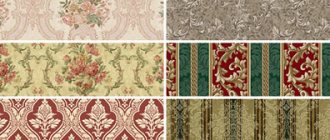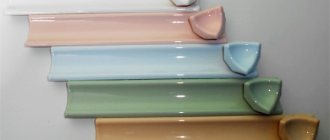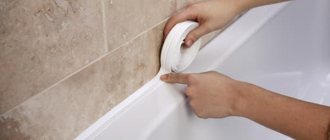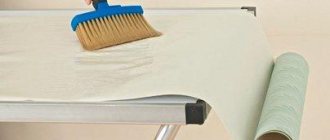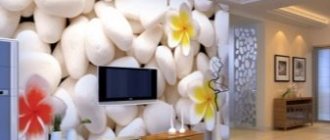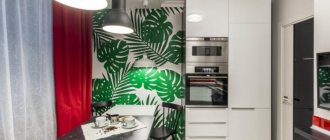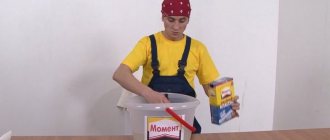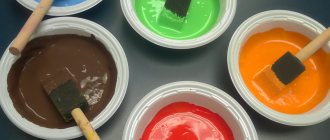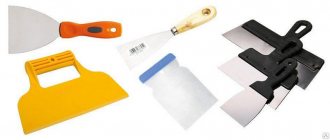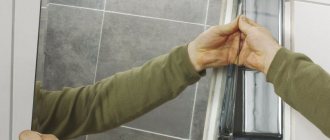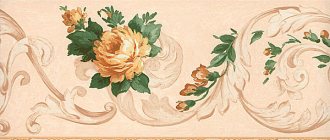With the help of a special strip for walls, it will not be difficult to successfully decorate the room, creating in it a comfortable and cozy atmosphere of completeness. Wallpaper border is used to delimit, expand, and also reduce a room. For example, if it is necessary to emphasize the ceilings, a similar strip is glued at the top at the junction between the wallpaper and the ceiling. If several types of wallpaper material are used in a room, it can be used to easily separate different zones, creating an unusual atmosphere in the interior.
What is a decorative border for wallpaper
A similar decorative element is used to delimit walls in different rooms of the house. For example, it is impossible to do without it if there is a need to take care of the play area in the nursery. Children's border is a colorful and bright material with drawings of your favorite characters. There are many options for this material for the bedroom, living room or kitchen, so it won’t be difficult to choose the right colors.
The main features of the location of the border on the wall:
- Top of the wall. The stripe is presented in the form of a decorative edging, which creates a cozy atmosphere in the room.
- Ceiling perimeter. Here the border is a separator and zonator.
- Right on the floor. It is considered an excellent way to hide wallpapering flaws.
Some owners stick the wallpaper border vertically. This makes it possible to separate a certain zone. Sometimes such application is necessary for framing doors, windows or mirrors.
General points related to the border
There is currently a fairly wide selection of this material on the market. A smart decision would be to choose the edging directly when purchasing wallpaper. As a rule, a competent seller will be able to offer you several options for decorating your canvas.
Here it is important to decide in what style you want to decorate your home. You can select in different ways, in the first case you should focus on the color shade. For a calming atmosphere, use a tape of the same color as the wallpaper, but with a different shade
To add brightness and dynamism, you need to use opposite colors of the spectrum. The second method involves relying on a drawing. The design should be consistent with the ornament on the walls. It may differ in scale or color scheme, but it should still be similar.
Border with accent.
For what coatings is it used?
- If we talk about paper wallpaper, then this is for the most part an economical option; they are glued quickly and easily, but they do not last so long, they often lose their shine and fade. The most you can do is wipe off the dust with a dry cloth.
- Vinyl sheets are considered the most stable; they are not afraid of almost anything. They can be wiped with a damp sponge and even washed gently with gentle detergents. Vinyl is UV resistant and quite durable. You will get tired of them before they become unusable.
- Textile tapes are a specific product, their price is quite high and such finishing is suitable only for an interior made in a certain style. Here you can often find two-level wallpaper, to separate which a special border or frieze is used.
- There are also tapes with acrylic coating; they are quite durable and beautiful, but their price is lower than that of vinyl. Another advantage is that acrylic is a breathable coating.
- An interesting effect can be achieved by using synthetic colorless borders. They have a certain texture and are used in tandem with plain coatings for painting.
Children's theme.
Where can I glue the tape?
Wallpaper border tape can shade or separate. With low ceilings, it is better to put a narrow edging along the top and leave it at that. If you want to add some zest to the interior, then you should try to combine wallpaper of different colors, separating them with a border, but do not forget, the wider the tape, the lower the ceilings will appear, plus the tape is started either at the height of the window sill, or at 1/3 of the height of the wall . Otherwise, the ceiling will also drop significantly.
Separation of textile wallpaper.
As for the bottom edging, it is used extremely rarely and mostly to hide unevenly glued canvases.
The video in this article shows the general technique for working with wallpaper.
Wallpaper borders: self-adhesive and other types of materials
Today, many manufacturers make wallpaper borders with identical patterns, but they differ in size and material.
A large selection of modern wallpapers often makes it difficult to choose. Our material will help you not to get confused and make the right decision:
Below are the types of borders for walls, which are divided:
- To size. The width of the curb may vary significantly. It varies from a few cm to a meter. A standard roll holds 5-10 meters of material.
- By color. Some products are plain, while others have designs.
- By type of fastening. There are self-adhesive borders - these are special borders on which a special adhesive substance is applied. Such products have a special protective film, so the material is easy to use even for a beginner. When gluing other models, it is enough to moisten the material with water (the glue is applied to them during production). Other types must be treated with glue intended for these purposes.
- By texture. Some products are smooth, while others have a variety of embossing.
- According to external features. There are simple borders for wallpaper (regular pattern or holographic pattern), as well as decorative models (lace or gilded).
- By topic. For a certain room (kitchen or children's room) in the house there are the most suitable models, with corresponding drawings.
In addition to the above characteristics, wallpaper borders differ in material.
Paper
They belong to the budget category and are easy to use. However, this material is short-lived and cannot be washed.
Vinyl
They are considered to be of higher quality, easy to clean and adhere to. Such decorative products will last for many years. This type of baguette is recommended for use in rooms with increased pollution (kitchen, bathroom or dressing room). They have a porous base, which allows the walls to “breathe”.
Acrylic
Borders made from this material are of high quality and have many positive characteristics. Here a special acrylic emulsion is applied to the surface of the strip.
Combined wallpapers are becoming increasingly popular. Which ones are best suited to your room, read on the next page:
Nuances of choice
To successfully select a tape, you need to pay attention to the following points:
The main differences between borders
Next, we will take a closer look at all the nuances of the choice.
Design
When choosing a tape design, you need to focus on the appearance of the wallpaper, namely the following features:
Color. There is no need to match the strip to the color of the trellis, as it will blend in with the wall decoration, but at the same time, the tone of the border should be in harmony with the wallpaper. If you can’t decide on a color, to avoid making a mistake, choose a stripe that matches the pattern on the wallpaper. Another win-win option is to choose a strip to match the floor plinth;
The tape should be in harmony with the wall decoration
Pattern. It should be done in the same style both on the walls and on the tape. Currently, you can find stripes with any designs and patterns: ornaments, geometric shapes, floral themes, etc. You can even purchase a children's border depicting various cartoon characters or bright drawings.
Width
The strip width can be from 15 to 100 mm. Wider borders are also available, but they are used less frequently.
In rooms with low ceilings it is better to use narrow strips
When choosing the width, be guided by your own wishes, but keep in mind that a wide strip visually makes the room lower. Therefore, if the ceilings in the room are low, it is better to use tapes no more than 30-40 mm wide.
In the photo - paper borders
Materials
Currently, the following types of borders can be found on sale:
- Paper. The cheapest ones, however, are not resistant to moisture, and therefore do not tolerate wet cleaning. In addition, over time they fade in the sun. Therefore, it only makes sense to use paper tapes with paper wallpaper;
- Non-woven (vinyl). They withstand moisture very well, making them suitable for wet cleaning. I am sure that you have guessed for which fabrics vinyl borders are best suited - non-woven wallpaper;
For non-woven wallpaper there is a special non-woven border
- Acrylic. In appearance and characteristics they resemble vinyl tapes, but thanks to the acrylic coating they are even more durable and durable. They can be used with any washable wallpaper;
- Textile. Designed specifically for walls covered with fabric wallpaper.
How to make a wallpaper border with your own hands
Some owners prefer to make their own border for the walls. The most common way is to use other wallpaper. It is necessary to mark a line of the required width in advance and carefully cut a strip along it.
Interesting! To make an unusual border for wallpaper, you can use a variety of piece materials, as well as decorative plaster.
But there is a more creative approach to the process of making a border with your own hands. If this product must be small in size, you can make it using photographs. This option will be an excellent solution for decorating a children's room.
The most suitable materials for creating this wall detail yourself are:
- Postcards or pieces of cardboard;
- Textile materials, as well as colored sheets of fluorescent paper;
- The film is self-adhesive.
Modern designers also use old magazines, posters, and old record covers to create unusual wallpaper borders. The result will depend entirely on the imagination and efforts of the decorator.
Wallpaper for the bedroom should have a calming effect. What color should this wallpaper be? The answer to the question is in our article:
How to choose based on wallpaper design?
The choice of border strips must be approached carefully. They are purchased taking into account the classification, which must be taken into account as a matter of priority. Each room has its own functionality, and therefore the decoration should be individual.
Wallpaper strips for walls or ceilings are usually selected taking into account the color or pattern combination. The interior should be maintained in the same style, without a hint of aggressiveness or vulgarity.
Bright and colorful ribbons are bought for those rooms where the emphasis is placed specifically on the walls. These areas are not loaded with furniture at all. In order not to make a mistake with the choice of color, it is worth choosing the edging to match the wallpaper pattern. There is another win-win option: choose a material to match the floor plinth.
The choice of width matters. Narrow borders for wallpaper allow you to visually adjust the height of wall ceilings. If you glue bright, and even wide, ribbons under the ceiling, you can visually shorten the height of the walls. If the ceiling is low, it is worth gluing tapes no more than 3-4 cm wide.
If you need to play up the height of the walls, you should bet on color. For example, white stripes will visually erase the boundary between the wall and the white ceiling. Due to this, the walls will appear higher. At the same time, dark (for example, brown, burgundy) ribbons will only further emphasize the limited space.
When choosing products with a pattern, it is worth considering the area of the room. For small rooms you need to buy narrow varieties with small and simple patterns. Plain piping can also be an excellent solution. The walls and ceilings of spacious rooms can be decorated with wide borders with a suitable theme of stylistic choice.
Today it is fashionable to choose stripes in the same style as wallpaper. They have the same pattern as the wallpaper, but in a smaller format. This technique gives the design integrity and harmony. Patterned borders are also suitable for plain wallpaper. In this case, they set the mood for the entire interior and do not overload the space.
To frame the rooms you need to buy the same materials. For paper wallpapers you need paper strips; for vinyl wallpapers you should choose vinyl friezes. For textile wallpaper, woven edgings are purchased.
How to glue a border to wallpaper: application features
Before gluing the border, it is recommended to check it for flaws; to do this, it is better to look at the entire tape. After this, you need to take care to clean the surface of the walls from dust, so the gluing will be more uniform.
You should not start pasting the border until the wallpaper is completely dry. Indeed, unlike a dry surface, the strip will not adhere well to wet material.
When choosing glue for this product, it is recommended to give preference to glue made on an acrylic base. Because it can be used without dilution with water. Plus, the tube comes with a special brush applicator and this glue is very durable.
The whole process of covering walls with wallpaper border is not difficult. However, it is necessary to take care of perfectly smooth surfaces in advance. It is also recommended to use a building level. Using a pencil and level, you need to mark the height of the product. It must be the same everywhere.
After this, you should break the roll into pieces of the required length. Each piece of the piece is then laid face down to apply the adhesive. To make the process easier, it is recommended to fold the canvas in the form of an accordion (with the side with glue applied to it inside).
All that remains is to apply the strip evenly to the wall and smooth it out well. When smoothing, it is better to move from the middle of the border to its edges. It is important to ensure that the canvas is completely glued.
Important! Each border strip should be combined with the previous one. In the corners, these products must be glued with an overlap.
The role of the wall border in the interior
If a floor border is used to zone space and organize ceramic “carpets,” then the main tasks of a wall border are separation and organization. In interiors where several types of decorative tiles are used, borders help to play up the design solution so that the image of the interior becomes more complete and status.
Background separation
A border allows you to separate one color from another when there are several tones in the interior. The transition becomes sharper and more pronounced, and the room is immediately divided into zones. This option for using a border is offered by Cersanit designers in the APEKS collection.
Separation of tile laying from finishing with decorative plaster or paint
Another decorative border feature implemented in the DECO MIX collection. The transition becomes pronounced, zones are designated in the room.
Separating the background from the decoration
Borders often separate the base tile from the decor, which enhances the beauty of the design of the decorative tile and emphasizes or complements its pattern. The transition between tiles with different patterns and textures becomes smooth, as in the AVANGARDE collection.
Framing the scenery
Using borders, you can create a “frame” for the panel, and then it, like a painting, will become an accent element of the interior. The decoration is often framed with a border on both sides to make it richer and more expressive, as in the ASAI collection.
Strengthening the border layout
Decors laid using the “border laying” technique look much more expressive in combination with borders. A metal border enhances the shine of the decor if it uses gold or silver plated elements, as in the OMNIA collection.
DIY decor
Fashionable shiny metal borders can become an independent decoration element. If a thin border is laid out in rows between ceramic tiles, the result will be a pattern of parallel lines. A horizontal arrangement will expand the room, a vertical arrangement will make the ceiling visually higher. The metallic shine of the borders will add luxury to the interior, as in the CARAVAN collection.
Borders for wallpaper (photo)
Fashionable transformations of wall borders
Curbs have changed a lot over the last 20 years.
If in the 2000s this type of insert duplicated or played up the decor of the collection, was bright, striped or floral, then in the 2010s it became more restrained, got rid of traditional classical designs and acquired its own sound, turning into a unit almost independent of the collection. Today, borders with the effect of shine and shimmer are in fashion, which are used to decorate modern interiors in a minimalist aesthetic, as well as in rooms with a modern classic character. Each style has its own border, for example:
- minimalism is laconic and restrained borders, decorated with geometric patterns, abstraction or imitating natural materials;
- Art Nouveau - decorative elements in this style lack symmetry, they are more like works of art, based on smooth and elegant lines;
- country and Provence - friezes are usually decorated with patterns in pastel colors, textures imitating aged or worn surfaces, small floral patterns or images of living plants;
- classic - restrained and graceful borders in soothing colors, often decorated with symmetrical stucco molding.
General description of wallpaper borders
So, wallpaper borders are a small strip of paper or vinyl, usually folded several times or rolled into a roll. Wallpaper borders are used to give wallpaper a finished look, if this is necessary according to the designer's idea.
Wallpaper border in the interior of a children's room
Such solutions in room decoration are used quite often, especially in cases where it is necessary to change the visual perception of the room. When used correctly, this small strip of paper can work wonders in lengthening or expanding a room. If the curb is used incorrectly, it is easy to achieve the opposite effect.
A border is in demand when a room needs to be demarcated into several independent zones. This is done using wallpaper of different colors and textures, and the border connects the space together.
Wallpaper border of the same texture with wallpaper, children's design
When purchasing wallpaper, it is recommended to immediately try to select a border, if necessary.
This way you can find a more suitable texture, for example, a paper border goes well with paper wallpaper, and for vinyl, a border that imitates vinyl or vinyl. You shouldn’t select it from memory; most likely you won’t guess the color and pattern.
You can transform a room and give it a fresh look not only by replacing the wallpaper, but also by re-gluing the border.
Varieties
There are several types of borders, which we will look at below.
By shape
Types by shape:
By material
By color
A wide variety of colors:
By purpose
It is always better to combine the type of border with the wallpaper or material on which it will be glued. For example, if the wallpaper is vinyl, then the edging is also vinyl.
There are decorated elements intended for pasting in the bathroom; they are characterized by moisture resistance. This is a tile type that is suitable for kitchen and bathroom.
Wooden borders are intended for kitchens or rooms in a country house. In a city apartment, this type of decor is unlikely to fit into the interior, although designers can do anything.
